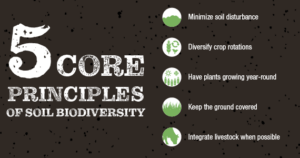Small Steps for Soil Health
Incremental strides to improve soil quality through regenerative agriculture are essential for biodiversity and productivity.

For farmers, the call to feed the world is not new, but the target is ever evolving. With a growing global population projected to exceed 9.7 billion by 2050, the stakes keep getting higher. But as those in the agriculture industry know, the foundational resources for growing a healthy food supply are not infinitely available.
“It’s not an exaggeration to say that our global food supply is vulnerable,” explains Matt Wallenstein, Ph.D., chief soil scientist at Syngenta Group. “As the demand for food increases, we have to figure out how to meet that demand by increasing productivity while minimizing environmental impacts. And that means that we need to put more focus on soil health.”
Preserve Soil Biodiversity
In August, the Proceedings of the National Academy of Sciences published findings from the latest attempt to measure biodiversity in soils. Led by the Swiss Federal Institute for Forest, Snow and Landscape Research (WSL), they estimated that soil is likely home to 59% of life, including everything from microbes to mammals, making it the singular most biodiverse habitat on Earth.1
With about one-third of global land being used for agriculture2, growers have a significant opportunity to improve and stabilize the quality of the world’s soil to preserve its rich biodiversity and its crucial role for human nutrition.
“Most of the food we produce on Earth relies on soils, and over time, a lot of soils have been degraded across the planet,” Wallenstein says. “It’s critical to the future of agriculture to minimize any further damage through erosion and lost organic matter and help identify practices that improve soil over time. At Syngenta, there’s a high-level conviction that soil science is critical to the future.”
We’re at a turning point in history. In the past, there was often a tradeoff between productivity, profitability and sustainability. But thanks to new scientific insights and technology that’s not the case anymore.
Soil Health and Regenerative Ag
Globally, Syngenta is committed to partnering with growers to identify ways they can restore and protect soil on agricultural land. With methods often referred to as regenerative agriculture, Syngenta is focused on educating and equipping growers with technologies that nurture and restore soil health; protect the climate, water resources and biodiversity; and enhance farm productivity and profitability.
There are five core principles growers can implement to help maintain soil and the biodiversity it harbors:
- Minimize soil disturbance
- Grow plants year-round
- Diversify crop rotations
- Keep the ground covered
- Integrate livestock when possible
Using precise applications of biological and chemical inputs is also effective management as the five soil health principles are adopted by growers.
While none of these practices are new, advancing technology is making them more attainable and attractive to growers.
“Regenerative agriculture is part of the toolbox that growers have access to and we are adding more science-based and logistics-based information as it becomes available,” says Abbey Wick, Ph.D., Soil Health Academy lead for the Syngenta Group. “A lot of these practices are grounded in solid agronomics. They are approaches that growers used generations ago or practices growers have always thought about doing. They are resurfacing as a new way to solve problems on the farm. And now there’s a lot more support that goes with these practices, which I think is making them more practical for growers to adopt.”
Advancements in scientific understanding have given rise to new information about soil and the life it sustains above and below ground. With the development of innovative technologies, growers now can be highly productive and improve their soil health.
“We’re at a turning point in history,” Wallenstein says. “In the past, there was often a tradeoff between productivity, profitability and sustainability. But thanks to new scientific insights and technology that’s not the case anymore.”
Attainable Agriculture
Tilling is one of the oldest agricultural practices to help manage weeds and fertility. However, new technologies like highly effective herbicides and precision agriculture tools allow growers to achieve the same outcomes with reduced or no tilling, which minimizes soil disturbance. And with less disturbance comes greater moisture retention, erosion prevention and carbon sequestration.
However, for many growers, the thought of altering their successful growing practices on the same land they have managed for decades can be overwhelming. But any practice, big or small, that focuses on maintaining healthy soil is a step in the right direction.
“We aren’t expecting farmers to use all of the practices within soil health or regenerative systems,” Wick says. “But adding practices that fit the farm logistics, like reducing fall tillage to leave the soils protected with residue going into the winter months, is a step in the right direction. And over time, those incremental changes add up to transformative progress.”
Similarly, growers in some areas plant cover crops to keep roots in the ground over winter. But if these crops are unsaleable, this practice can be costly. Again, advances in science can have a positive impact on growers. Just this summer, Syngenta Seeds announced it will be selling camelina ― an ultra-low carbon oilseed crop that can be used as feedstock for renewable fuels and an ingredient for sustainable animal feed ― to provide a cash alternative to fallow fields.
“Cover crops aren’t harvested, so farmers are spending money on a crop that’s going to benefit their soil but not their bottom line in the short-term, which is great. That can be a hard investment to make,” explains Wallenstein. “It’s exciting when there are opportunities to grow a winter crop that provides some income. The recent announcement from Syngenta on the collaboration with Sustainable Oils, Inc. to sell camelina will be a nice alternative in some locations.”
Identify Soil Health Improvements
With today’s advancements in science and technology, regenerative agricultural practices are very tangible. For growers, it’s an opportunity to identify one or two ways they can do something different that makes sense for their operation and enables them to take positive steps for soil health and the environment.
“For growers, the first thing to consider is how much acreage are they comfortable with trying something new on,” Wick says. “Then they can evaluate what problems exist in a field that are the lowest hanging fruit for implementing a new practice with the potential to manage the system more effectively. For example, it could be just planting a cover crop to use moisture in parts of a field that are otherwise too wet to access. Even if only 10% of the field is impacted, the grower can see firsthand the benefits of planting that cover crop.”
At the end of the day, soil health is a holistic view of how well the soil is performing for its intended purpose. Soil is a rich habitat that is physically, chemically and biologically complex. But by optimizing soil conditions using regenerative agriculture practices and biological products, growers can better achieve their intended outcomes.
“Soil health is an exciting focus for agriculture because we have amazing new technologies and solutions for problems that, in the past, were intractable,” says Wallenstein. “And we’re just at the start with more to come.”
¹ M.A. Anthony, F.S. Bender, M. van der Heijden (2023). Enumerating soil biodiversity.
PNAS, https://doi.org/10.1073/pnas.2304663120.
² FAO. 2023. Land use statistics and indicators 2000–2021. Global, regional and
country trends. FAOSTAT Analytical Briefs Series No. 71. Rome.
https://www.fao.org/documents/card/en/c/cc6907en
- Understanding soil science and improving soil quality are critical for the future of agriculture.
- Key regenerative agricultural practices can improve soil health.
- Growers should identify small steps they can take to make incremental improvements in the health of their soil.
























